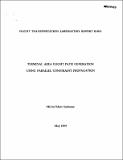| dc.contributor.author | Sadoune, Michel | en_US |
| dc.contributor.other | Massachusetts Institute of Technology. Flight Transportation Laboratory | en_US |
| dc.date.accessioned | 2012-01-06T22:22:47Z | |
| dc.date.available | 2012-01-06T22:22:47Z | |
| dc.date.issued | 1989 | en_US |
| dc.identifier | 29339140 | en_US |
| dc.identifier.uri | http://hdl.handle.net/1721.1/68092 | |
| dc.description | Cover title | en_US |
| dc.description | May 1989 | en_US |
| dc.description | Also issued as an Ph.D. thesis, Massachusetts Institute of Technology, Dept. of Aeronautics and Astronautics, 1989 | en_US |
| dc.description | Includes bibliographical references (p. 175-181) | en_US |
| dc.description.abstract | A Flight Path Generator is defined as the module of an automated Air Traffic Control system which plans aircraft trajectories in the terminal area with respect to operational constraints. The flight path plans have to be feasible and must not violate separation criteria. The problem of terminal area trajectory planning is structured by putting the emphasis on knowledge representation and air-space organization. A welldefined and expressive semantics relying on the use of flexible patterns is designed to represent aircraft motion and flight paths. These patterns are defined so as to minimize the need for replanning and to smoothly accommodate operational deviations. Flight paths are specified by an accumulation of constraints. A parallel, asynchronous implementation of a computational model based on the propagation of constraints provides mechanisms to efficiently build feasible flight path plans. A methodology for a fast and robust conflict detection between flight path plans is introduced. It is based on a cascaded filtering of the stream of feasible flight paths and combines the benefits of a symbolic representation and of numerical computation with a high degree of parallelism. The Flight Path Generator is designed with the goal of implementing a portable and evolving tool which could be inserted in controllers' routine with minimum disruption of present procedures. Eventually, a model of aircraft interaction provides a framework to rethink the notion of Separation Standards. | en_US |
| dc.format.extent | x, 181 p | en_US |
| dc.publisher | [Cambridge, Mass. : Massachusetts Institute of Technology], Flight Transportation Laboratory, [1989] | en_US |
| dc.relation.ispartofseries | FTL report (Massachusetts Institute of Technology. Flight Transportation Laboratory) ; R89-1 | en_US |
| dc.subject | Air traffic control | en_US |
| dc.subject | Flight control | en_US |
| dc.subject | Trajectory optimization | en_US |
| dc.subject | Parallel processing (Electronic computers) | en_US |
| dc.subject | Automation | en_US |
| dc.subject | Mathematical models | en_US |
| dc.title | Terminal area flight path generation using parallel constraint propagation | en_US |
| dc.type | Technical Report | en_US |
